 G-Technology's G-RAID Removable Drive Storage System is a 2-bay attached storage device intended for media professionals that want a large capacity (at a lower cost) for low-demanding use cases. The G-RAID would be appropriate for high-definition streaming, photo editing, or just straight-forward storage. G-Technology loads the G-RAID with two of its standard 7200RPM HGST SATA III HDDs with total capacity options of 12TB, 8TB, or 6TB. This storage solution, which is compatible with both Mac and Windows workstations, offers varied interfaces (USB 3.0, FireWire, and eSATA) to appeal to a broad range of users as well as provide compatibility with older devices. It reportedly achieves transfer speeds of up to 330MB/s (12TB, RAID0), and can be configured in RAID0, RAID1, and JBOD. Like many of G-Technology's offerings, the G-RAID has a built-in RAID controller, allowing it to be easily shared rather than confined to a single workstation.
G-Technology's G-RAID Removable Drive Storage System is a 2-bay attached storage device intended for media professionals that want a large capacity (at a lower cost) for low-demanding use cases. The G-RAID would be appropriate for high-definition streaming, photo editing, or just straight-forward storage. G-Technology loads the G-RAID with two of its standard 7200RPM HGST SATA III HDDs with total capacity options of 12TB, 8TB, or 6TB. This storage solution, which is compatible with both Mac and Windows workstations, offers varied interfaces (USB 3.0, FireWire, and eSATA) to appeal to a broad range of users as well as provide compatibility with older devices. It reportedly achieves transfer speeds of up to 330MB/s (12TB, RAID0), and can be configured in RAID0, RAID1, and JBOD. Like many of G-Technology's offerings, the G-RAID has a built-in RAID controller, allowing it to be easily shared rather than confined to a single workstation.
G-Technology's G-RAID Removable Drive Storage System is a 2-bay attached storage device intended for media professionals that want a large capacity (at a lower cost) for low-demanding use cases. The G-RAID would be appropriate for high-definition streaming, photo editing, or just straight-forward storage. G-Technology loads the G-RAID with two of its standard 7200RPM HGST SATA III HDDs with total capacity options of 12TB, 8TB, or 6TB. This storage solution, which is compatible with both Mac and Windows workstations, offers varied interfaces (USB 3.0, FireWire, and eSATA) to appeal to a broad range of users as well as provide compatibility with older devices. It reportedly achieves transfer speeds of up to 330MB/s (12TB, RAID0), and can be configured in RAID0, RAID1, and JBOD. Like many of G-Technology's offerings, the G-RAID has a built-in RAID controller, allowing it to be easily shared rather than confined to a single workstation.
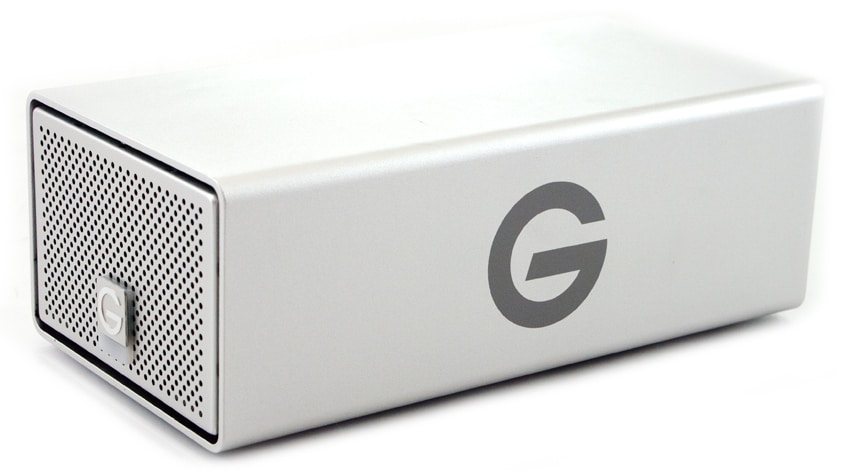
The G-Technology family appeals to a wide range of users with their suite of attached storage products; prospective buyers can find the perfect device by weighing the importance of four factors: performance, capacity, connectivity, and price. The G-RAID line provides lower performance, good capacity, and unique connectivity for a relatively low price. The G-RAID Studio would provide enhanced performance with the same capacity options through Thunderbolt 2 connectivity. The recently reviewed G-SPEED Studio is another step up with even better performance and larger capacity options with Thunderbolt 2 connectivity. It all depends on the desired specifications and price, and the G-RAID is best-equipped to serve entry-level media professionals that need compatibility with lots of interface types.
The G-RAID system carries a 3-year warranty and costs $449.95, $749.95, and $1,199.95 for the 4TB, 8TB, and 12TB models, respectively.
Specifications
- Capacities
- 12TB (0G03411)
- 8TB (0G03244)
- 4TB (0G03240)
- Spare Drives
- 6TB (0G03508)
- 4TB (0G03507)
- 3TB (0G03506)
- 2TB (0G03505)
- Interfaces: 1x USB 3.0, 2x FireWire 800, 1x eSATA
- Disk
- (2) "Enterprise-class" (HGST)
- 7200RPM
- SATA III
- Transfer Rates
- 12TB: 330MB/s
- 8TB: 300MB/s
- 4TB: 300MB/s
- RAID Configurations: RAID0, RAID1, and JBOD
- Compatibility/System Requirements
- Mac OS 10.7+
- Windows 8.1, 8 and 7 (via reformat)
- Size (L x W x H): 9.92" x 5.12" x 3.58" (252mm x 130mm x 91mm)
- Kit Contents
- G-RAID dual-drive storage system
- (1) USB 3.0 cable
- (1) eSATA cable
- (1) FireWire cable
- AC power supply
- Quick Start Guide
- Warranty: 3-year limited
Design and Build
The G-RAID chassis pairs perfectly with a Mac-oriented workstation, although it would look fine with a Windows setup as well. It has a simple aluminum enclosure with a rectangular shape overall and branding along almost every surface.
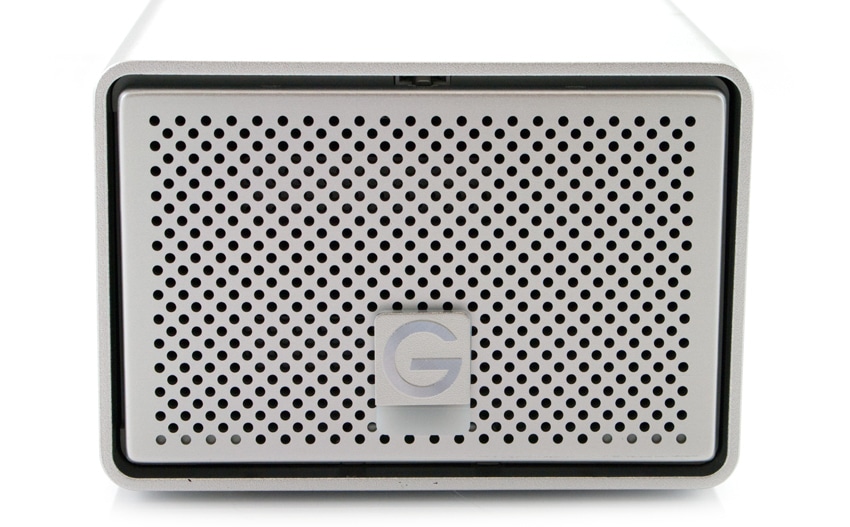
The face is a vented door that is hinged along the bottom, allowing it to open downwards exposing the two bays. Depression of the branded ejection button causes the vented bay face to swivel outward, retracting the drive.
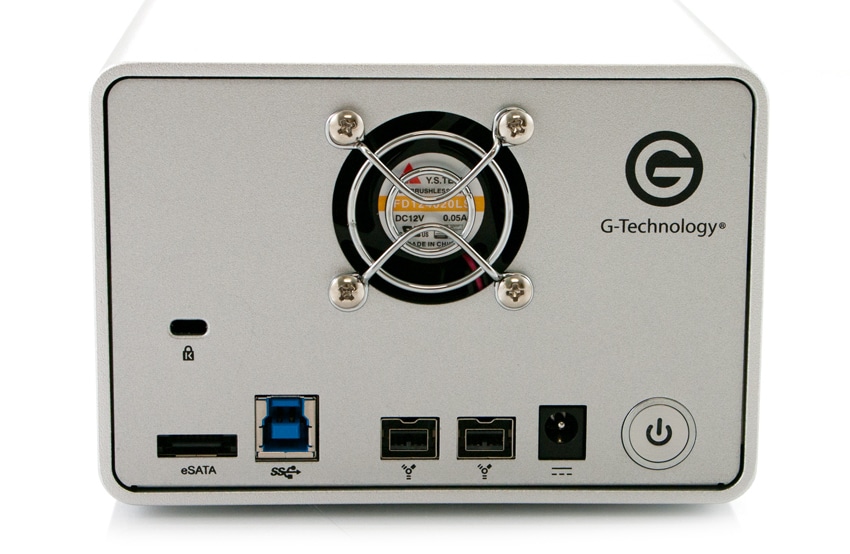
The back of the device is centered by the fan with the Kensington lock to the left and power button to the right. It houses an eSATA port, a USB 3.0 port, two FireWire ports, and an AC adaptor. The most obvious omission is the Thunderbolt port, which we've come to expect in desktop storage targeted to this market.
Usability
The G-Tech G-RAID has an on-board RAID controller that means once the RAID is set, the unit can be readily shared between multiple user systems. That differentiates from software RAID solutions that are managed by the host system.
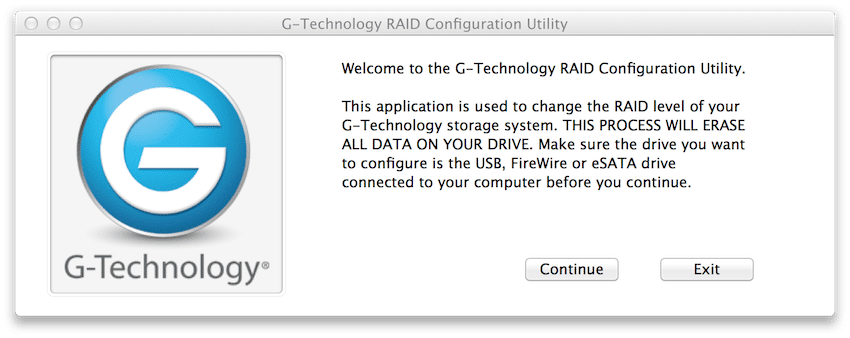
The installed application is pretty simple to install and select the desired RAID setting. The software-based solution contrasts to a hardware switch or the like that is sometimes used in solutions like this.
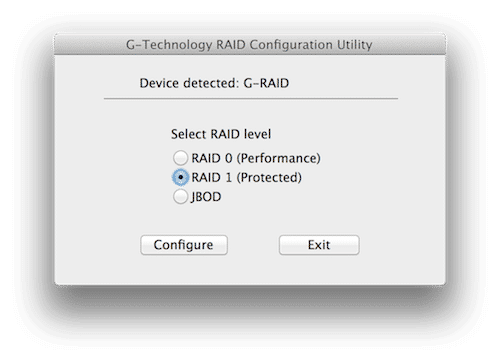
Performance
We measured transfer speeds from the G-RAID by connecting it a current generation MacBook Pro and using the Blackmagic Disk Speed Test with a 5GB test file and USB 3.0 interface. Its performance is compared herein to the LaCie 2big and WD My Book Duo. The 2big is a 2-bay attached storage device designed for similar use-cases at a similar price-point with slightly higher transfer speeds with Thunderbolt 2 connectivity (6TB, 8TB, and 12TB for $599, $799, and $999, respectively). The My Book Duo is also intended for similar use-cases but appeals more to less demanding use-cases with slower transfer speeds and a much lower price point (4TB, 6TB, and 8TB for $280, $350, and $450, respectively). The My Book Duo only provides USB 3.0 connectivity but it allows for a JBOD configuration in addition to RAID0 and RAID1. G-RAID and 2big were tested using 6TB HDDs and the My Book Duo was tested using 4TB HDDs. All devices were tested with two drives in both RAID0 and RAID1.
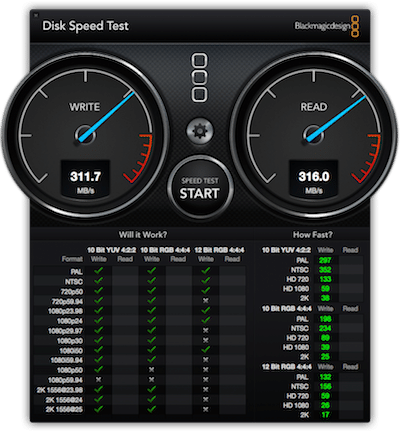
The G-RAID was first tested in RAID0. It performed in the middle of the pack with read and write speeds of 316MB/s and 311.7MB/s, respectively. The 2big was the top performer in both read and write with 412.7MB/s and 353.3MB/s, respectively, vs. 254.7MB/s and 223MB/s from the My Book Duo.
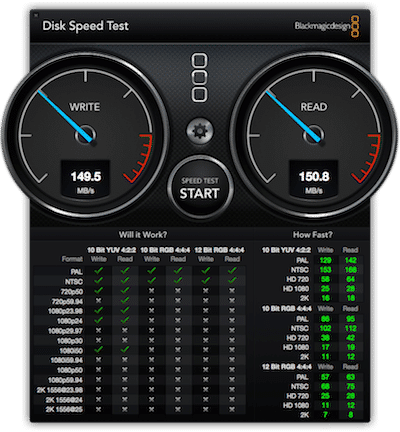
We also tested the G-RAID configured in RAID1, and the standings were exactly the same; 2big was the leader in both read and write (202.3MB/s and 199.4MB/s), followed by G-RAID (150.8MB/s and 149.5MB/s) and My Book Duo (148.2MB/s and 148MB/s). However, in RAID1 the G-RAID and My Book Duo were very close. The results appear appropriate given the drives and interfaces used for each version of 2-bay direct attached storage devices.
Conclusion
The G-RAID is one of G-Technology's many DAS options, geared more towards less-demanding use cases with various connectivity options (USB 3.0, eSATA, and FireWire). As with all of their DAS solutions, the G-RAID ships with 7200RPM HGST SATA III HDDs. The three capacity options (4TB, 8TB, and 12TB) should serve all of the needs of many types of media professionals, with decent performance at a relatively low price. Its built-in RAID controller allows it to be mobile rather than confined to a single workstation. That paired with the removable drives and small size of the device makes it perfect for professionals on the go.
As with many of G-Technology's offerings, the G-RAID seems to have been designed to be used alongside a Mac. However, it would also pair well with a Windows workstation after being reconfigured. It performed fairly well compared to the LaCie 2big and WD MY Book Duo, outperforming the My Book Duo handedly in RAID0 and maintaining second-place in RAID1, though by a narrow margin. It comes down to connectivity and configuration in the end, weighed against cost. The 2big posted faster transfer speeds but it is dependent on Thunderbolt 2 connectivity, and is designed implemented alongside a Mac workstation. In terms of performance and cost, G-RAID is in the same league, but offers almost every other interface used today. The My Book Duo carries a much lower price-point and performed very well in RAID1 (within 1MB/s of G-RAID in both read and write), but only provides USB 3.0 connectivity. It all depends on the specific needs of the user.
Pros
- Swappable drive bays, high-quality enclosure
- Wide range of interfaces
- Good performance in both RAID0 and RAID1
Cons
- No Thunderbolt connectivity
The Bottom Line
This G-Tech mid-line direct attached storage solution provides good performance across a wide range of interfaces with high-quality enclosure and a competitive price-point.
G-Technology G-RAID with Removable Drives at Amazon
